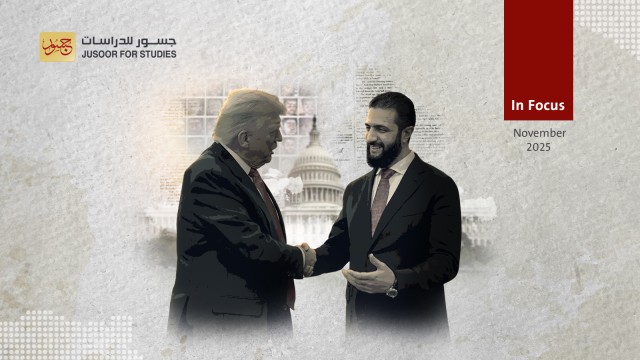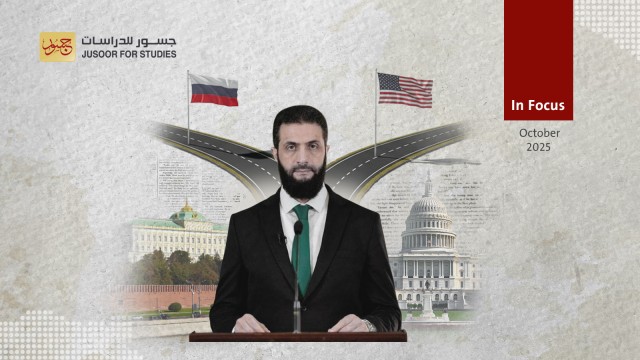The Future of Deir ez-Zor in the Light of Syrian Al-Badia Conflict
Font Size
Preface
Since the launch of Al Mosul Battle (mid of Oct 2016) and Ar-Raqqa Battle (late of May 2016) by US-led coalition and local militias, all eyes were focused on Deir ez-Zor and Syrian Al-Badia, considering them the last bastions of ISIS.
At that time, new mobilization from the Revolutionary Commando Army (Syrian New Army previously) took place, launching a large-scale attack from Al Tanf Base toward Al Bukamal (a major link between ISIS bastions in Iraq and Syria).
In Oct 2015, Iran and Russia were planning to infringe eastward (which was declared in Khmeimim Airbase) through supporting the Syrian regime forces for two main reasons:
- Clearing the route between Damascus and Baghdad from ISIS in order to provide a safe route between Tehran and the Mediterranean coast.
- Preventing the formation of any buffer in the east.
On 27th March 2016, militias supported by Moscow and Tehran were able to advance in Al-Badia and control Palmyra, however, those military operations were frozen due to the priority of fighting Syrian opposition factions along with insufficient resources to conduct two operations at the same time. Russia and Iran remobilized eastward after achieving major accomplishments (seizing Aleppo city, Palmyra and T4 Station) on the account of Syrian opposition.
The two countries realized that, heading to east needs sufficient military and human recourses along with freezing the other battles against Syrian opposition, which led to "de-escalation zones" agreement, since then, Syrian regime forces concentrated on Syrian Al-Badia (starting from east of Aleppo, Homs and Damascus reaching Al Bukamal).
Conflict in Al Badia is not limited only on Syrian regime and opposition, but also includes SDF (Syrian Democratic Forces), as the last party controlled Al Kabir nuclear station in Deir ez-Zor rural early of March 2017.
The Military Context and Map of Military Influence in Syrian Badia
Four main axes are dominating the map, represented by three local military forces: Syrian regime forces – FSA (Free Syrian Army) – SDF, all of them are supported by regional and international parties to work against ISIS, these axes are:
The central Axis: Starts from Palmyra (east of Homs) passes through Al Sukhna and T3 Station toward Deir ez-Zor and Syrian-Iraqi boarders in Al Bukamal.
Syrian regime militias fight ISIS in this axis, as they need to control Al Sukhna along with T3 Station in order to provide leverage points concerning the upcoming battle against ISIS in Deir ez-Zor, the thing that, threatens the eastern outskirts of Deir ez-Zor and provide advancement toward the north-west axis in the city.
The north-west Axis: Starts from eastern Aleppo rural (Rsafa city in particular) heads to Al Sukhna city and meets the central axis, starting points of this axis are controlled by Syrian regime militias while the rest is controlled by ISIS.
Seizing Rasafa city (south of Raqqa Governorate) by regime forces, outlined this axis, the common belief was, the desire of these forces to participate in Ar-Raqqa Battle, however, the main aim is to provide a new axis in Deir ez-Zor Battle, which is needed for advancing toward Al Sukhna city through controlling the whole southern Aleppo rural till the region between Rasafa and Atheria along with the area between Shaer Gas Field and Atheria.
It seems a daunting task, as the regime forces dominance was due to the widespread retreat of ISIS from Aleppo and Homs rural (keeping the organization's main defense and contact lines with the regime forces).
On the other hand, the main obstacle is represented by US, as the last party shows no desire in any progress from regime forces side in this axis (shooting down Sukhoi SU-22 aircraft in Rasafa was a clear example) with possibility of allowing SDF to advance from there.
The south-west Axis: starts from south of Palmyra to the triple frontier (Iraq – Syria – Jordan) along with As-Suwayda and Damascus governorates to be in parallel with the central axis then heads from Al Hamima village and T2 Station to Al Bukamal. The dominance upon this axis is distributed between Syrian regime forces and FSA with the existence of two US military bases in Al Tanf and Al Zakf.
FSA controlled large area of land during "Riding our horses to Clear Al Hammad Region" Battle (on 18th March 2017) after controlling the whole region between Eastern Damascus and Eastern As-Suwayda governorates reaching Al Sukhna and Talila reserve in order to interdiction of Syrian regime forces, the last party however, took control of the previously mentioned sites and continued toward Damascus-Baghdad route along with Bi'r Qassab and Tall Ad Dakwah, as a step to hinder the Syrian opposition advance in the east, securing Al Seen Military Airbase, T2 Station, Al-Dumayr Military Airport and defense lines of Eastern Ghouta and Qalamoun.
Syrian regime militias are seeking to reach Al Bukamal, a very vital location for them as attacks can be launched easily on ISIS or FSA.
Moscow and Tehran are trying to control Al Bukamal to secure T2 Station (for gas) along with Al Hamima region for the sake of building military base in the light of regime forces attempt to control T2, T3, T4 stations whilst Iran-supported militias are seeking control of T1 and T5 stations. Moreover, reaching Al Bukamal means securing Tehran and Mediterranean route in case Iraqi militias reached Al-Qa'im city.
The north-east axis: starts (the points are controlled by SDF) south Al-Hasakah Governorate to Madan city east of Raqqa, the axis heads in two ways:
First one: in parallel with Euphrates Valley cities till Deir ez-Zor.
Second one: in parallel with Tigris Valley cities till Deir ez-Zor.
SDF didn't participate in any battle concerning Deir ez-Zor except controlling areas in the north rural in order to cut off ISIS main supply line in Ar-Raqqa.
These advanced positions contribute in the possibility of SDF (either by its whole forces or through Arabic groups like Syrian Elite Forces led by Ahmad Al Jarba) participation in the upcoming Deir ez-Zor Battle after restructuring themselves.
This axis is considered one of the most significant concerning Deir ez-Zor Battle, as it covers ISIS most notable outposts in Al Jazire region (with valuable resources), it's well-known that, seizing Al Jazire region means controlling its counterpart in Syria southern region.
The Battle Expected Scenarios and Options
The military context of this battle, reflects the presence of many options and scenarios concerning the future of Deir ez-Zor, which are as the following:
1. Breaking the siege (on the long term) of Deir ez-Zor by Syrian regime militias, starting from Al Sukhna city. Accomplishing this scenario needs long duration (at least one year) due to the difficulty of controlling this city, inability to cover wide areas and difficult terrain.
2. Syrian regime militias involvement with long term attrition battles due to the difficult terrain and lack of sufficient of combatants.
3. Freezing the operations in Al Sukhna after controlling the city, knowing that, if Syrian regime forces controlled all other regions except Al Bukamal, it would be in vain and could lose all these areas within hours.
4. US-supported factions may launch a large-scale attack on Syrian regime militias (after suffering from attrition battles with ISIS) north of Al Zakf along with Al Waer dam in the north, this scenario needs huge number of combatants in order to reach Al Bukamal, otherwise Syrian Opposition factions will suffer from battles of attrition.
5. US moves trained combatants (related to Syrian opposition) to south of Al Hasakah Governorate, as a preparation for Deir ez-Zor Battle, avoiding any attrition of FSA forces in the north-west axis, focusing on defending its outposts in As-Suwayda and Damascus governorates.
6. US-led coalition intervenes (Jordan plays a main role in it) from the southern front in Al Tanf base in case of any threat from Syrian regime militias in controlling Al Bukamal or reaching the Syrian-Iraqi boarders.








